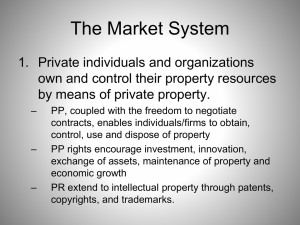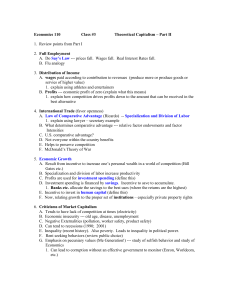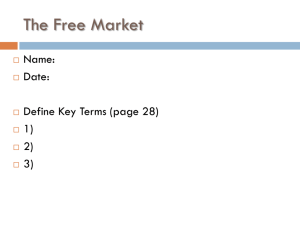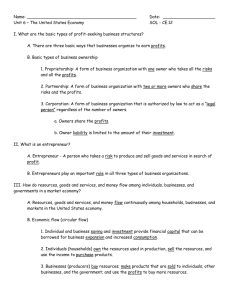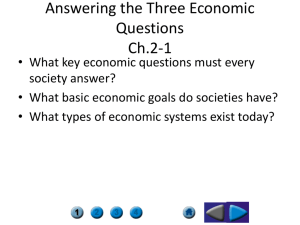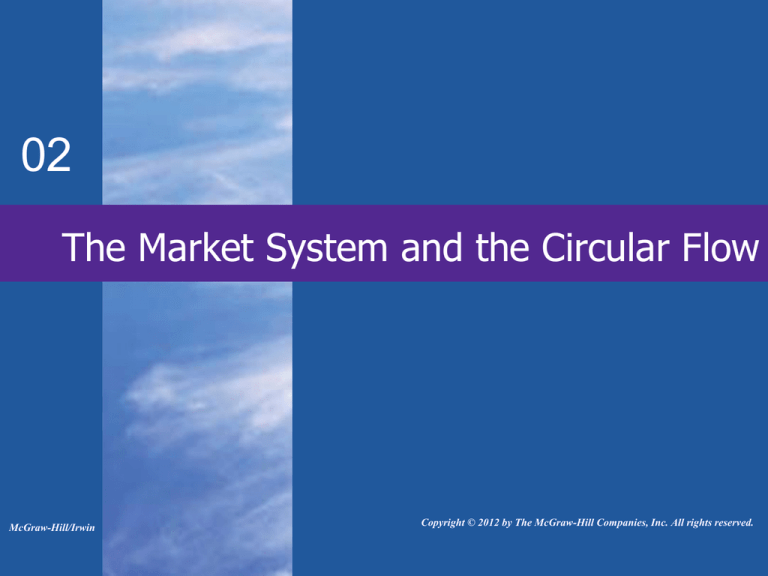
02
The Market System and the Circular Flow
McGraw-Hill/Irwin
Copyright © 2012 by The McGraw-Hill Companies, Inc. All rights reserved.
Economic Systems
•An economic system is a set of
institutional arrangements and a
coordinating mechanism to
respond to the basic economizing
problem. All economic systems
need to answer some basic
questions.
LO1
2-2
Basic Questions
What to produce
How to Produce
For Whom to Produce
How to Accommodate Change
How to Promote Technological
Change
Economic Systems differ in two
respects:
Who owns the factors of
production
The method used to coordinate
and direct economic activity
The Command System
•A Command System is also known
as socialism or communism. Here
the government owns most
property resources and economic
decisions are made through
central planning.
LO1
2-6
Examples include the former Soviet Union,
China, North Korea and Cuba. The government
basically answers the what, how and for whom
questions.
The Market System
•A market system, also called
capitalism, is characterized by
the private ownership of
resources and the use of markets
and prices to coordinate and
direct economic activity.
LO1
2-8
In pure capitalism or laissez faire
capitalism the government’s role would
be limited to protecting private property
and establishing an environment
appropriate to the operation of the
market system. Laissez Faire means “let
it be” and implies government should
not interfere with the economy or
people’s ability to make their own
decisions.
The capitalism practiced in the U.S. and
most other countries allows for
substantial government involvement.
In reality then all economic systems are
mixed. There are no purely command
or market economies in the world
today.
Characteristics of the Market System
Private Property- Private individuals and
firms, not the government, own most of
the property resources. People are able to
obtain, use, and dispose of their property
as they see fit.
LO2
2-11
Property rights encourage investment,
innovation, exchange and maintenance of
property because people know they will
reap any rewards from their efforts.
Property rights also extend to intellectual
property through patents, copyrights and
trademarks.
Freedom of Enterprise & ChoiceBusinesses, consumers and workers are
free to make economic decisions that are
in their best interest such as what products
to produce, how to spend income, and
what career to choose. It is clear that
economies that exhibit the highest degree
of freedom are also the most successful.
Global Perspective
LO2
2-14
Self-interest- simply means that each economic
unit tries to achieve its own particular goal,
which usually requires delivering something of
value to others. The motive of self-interest gives
direction and consistency to what might
otherwise be a chaotic economy. Entrepreneurs
try to maximize profits, property owners try to
get the highest price for the sale or rent of their
property, consumers attempt to maximize utility
from the various goods and services they buy and
employees try to get the highest wages and other
fringe benefits from their jobs.
Competition- competition requires large
numbers of buyers and sellers acting
independently in a given market and also
the ability to enter or leave markets easily
based on their self-interest.
Consumers benefit from competitive
markets because they get lower prices
and better quality products. Competition
is the basic regulatory force in the market
system.
Markets & Prices- The millions of decisions
made by households and businesses are
highly coordinated with one another by
markets and prices. A market is simply a
location or mechanism that brings buyers
and sellers together. A market system is a
communication network through which
many individual free choices are recorded,
summarized, and balanced.
Through this mechanism society
decides what the economy should
produce, how production can be
organized efficiently, and how the
resulting output can be distributed
to those who want it.
Technology & Capital Goods- A market
system encourages extensive use and
rapid development of capital goods and
technical improvements because
rewards accrue to the innovator.
Businesses who adopt capital goods and
the latest technology will lower costs
and therefore earn higher profits.
Specialization- Rather than trying to
produce all the goods and services
by themselves people, firms, regions
and nations specialize in one or a
few things.
Society learned long ago that selfsufficiency breeds inefficiency.
Human specialization is called division
of labor and has several advantages.
Specialization takes advantage of
differences in ability
Specialization fosters learning by doing
Specialization saves time
Use of Money- Money is an important
characteristic because it helps to
facilitate the exchange of goods and
services. It makes trade easier. A barter
economy involves exchanging goods for
goods or goods for services which is not
very efficient because it requires a
coincidence of wants.
Use of Money
• Makes trade easier
LO2
2-24
Active, but Limited GovernmentAlthough a market system promotes a
high degree of efficiency in the use of
its resources, it has certain inherent
shortcomings, called market failures. In
the event of such failures government
can increase the overall effectiveness
of a market system.
The Five Fundamental Questions
• What goods and services will be
produced?
• How will the goods and services be
produced?
• Who will get the goods and services?
• How will the system accommodate
change?
• How will the system promote progress?
LO3
2-26
What will be Produced?- The answer to this
question is twofold. The goods and services
that can be produced at a continuing profit
will be produced, while those whose
production generates a continuing loss will be
discontinued. When TR>TC profits result but
when TR<TC firms incur losses. Continuing
profits in an industry result in expanded
production and the movement of resources
toward that industry. Existing firms grow and
new firms enter.
The second question relates to consumer
sovereignty which states that consumers
“rule” the market by the way they spend
their money referred to as dollar votes.
Businesses must match their production
choices with consumer choices or else
face losses and eventual bankruptcy.
How will goods & services be produced?What combinations of resources and
technology will be used to produce goods
and services? Production will occur in the
least costly way which depends on the
available technology and the prices of the
necessary resources. Economic efficiency
requires obtaining a particular output with
the least input of scarce resources, when
both output and resource inputs are
measured in dollars and cents.
How Will the Goods Be Produced?
Three Techniques for Producing $15 Worth of Bar Soap
Units of Resource
Price per
unit of
Resource
Resource
Technique 1
Unit
s
$
Technique 2
Cost
Technique 3
Cost
Units
Units
8
2
$ 4
1
Cost
Labor
$2
4
Land
$1
1
1
3
3
4
4
Capital
$3
1
3
1
3
2
6
Entrepreneur
$3
1
3
1
3
1
3
$ 15
LO3
$ 13
$
2
$ 15
2-30
Who will get the output?- Generally
any output will be distributed to
consumers on the basis of their
ability to pay the market price, and
of course one’s ability to pay is
based on income.
How will the system accommodate
change?- Market systems are dynamic.
Consumer preferences, technology and
resource supplies all change. What if the
demand for fruit juice increases and the
demand for milk decreases? What is the
result? The guiding function of prices and
profits will bring about the necessary
changes.
How will the system promote
progress?- Entrepreneurs are driven by
profits. As they adopt new technology
and purchase capital goods costs will
fall resulting in greater profits.
Invisible Hand
• Wealth of Nations- 1776
• Adam Smith noted that firms and resource
suppliers, seeking to further their own selfinterest will also, as though guided by an
invisible hand, promote the public interest.
• “It is not from the benevolence of the
butcher, baker , or brewer that we expect our
dinner, but from their regard for their own
self-interest.”
LO4
2-34
Virtues of a Market System
• A market system promotes the efficient use of
resources by guiding them into the production
of the goods and services most wanted by
society.
• A market system encourages skill acquisition,
hard work, and innovation. Successful
innovation generates economic rewards.
• A market system also promotes personal
freedom. In contrast to central planning, a
market system coordinates economic activity
without coercion.
LO4
2-35
Circular Flow Model
The dynamic market economy creates
continuous, repetitive flows of goods
and services, resources, and money.
This model illustrates these flows for a
simplified economy in which there is no
government.
Households- are defined as one or more
persons occupying a housing unit.
Households buy the goods and services
that businesses make available in the
product market. Households obtain the
income needed to buy those products by
selling resources in the resource market. It
is assumed that all resources in our no
government economy are owned by
households so they also receive all the
income.
Businesses- are commercial establishments that
attempt to earn profits for their owners by
offering goods and services for sale. Businesses
are typically 1 of 3 types.
•Sole proprietorships- a business owned and run
by 1 person.
•Partnership- a business owned by 2 or more
people.
•Corporation- a separate legal entity recognized
by law as having all the rights of an individual.
Businesses sell goods and services in the
product market in order to obtain
revenue, and they incur costs in the
resource market when they purchase
the labor, land, capital, and
entrepreneurial ability they need to
produce their respective goods and
services.
Two Types of Markets
Product Market- Is the place where
goods and services are bought and
sold.
Resource Market- is the place where
resources are bought and sold.
The Circular Flow System
RESOURCE
MARKET
•Households sell
•Businesses buy
BUSINESSES
• buy resources
• sell products
HOUSEHOLDS
• sell resources
• buy products
PRODUCT
MARKET
•Businesses sell
•Households buy
LO5
2-41

